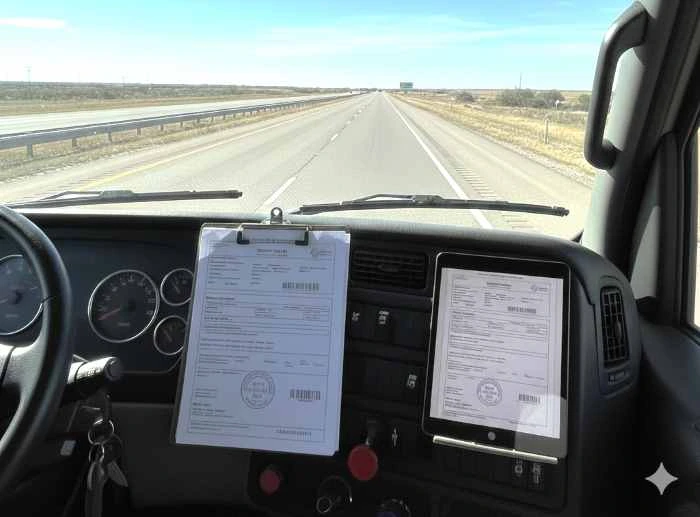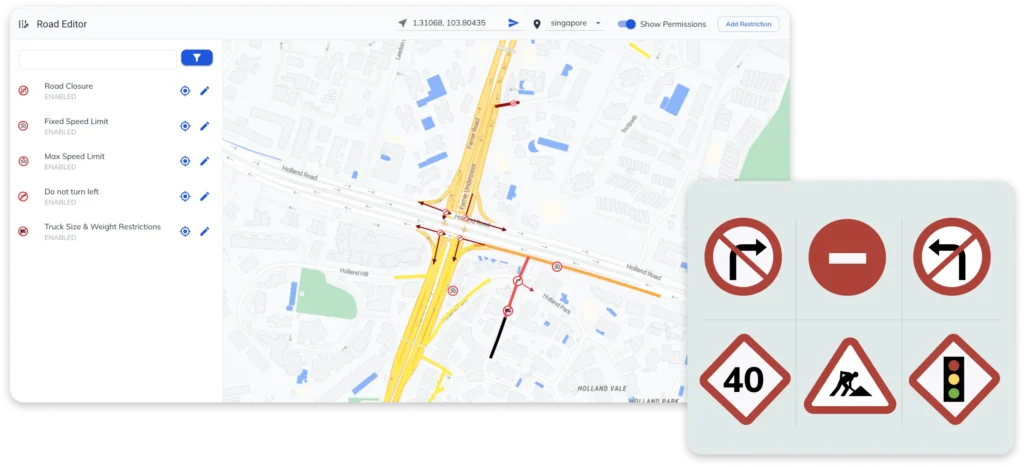

- BLOG
Role of AI and LLMs in Freight Permit Processing
Published: November 17, 2025
Route Optimization API
Optimize routing, task allocation and dispatch
Distance Matrix API
Calculate accurate ETAs, distances and directions
Directions API
Compute routes between two locations
Driver Assignment API
Assign the best driver for every order
Routing & Dispatch App
Plan optimized routes with 50+ Constraints
Product Demos
See NextBillion.ai APIs & SDKs In action
AI Route Optimization
Learns from Your Fleet’s Past Performance
Platform Overview
Learn about how Nextbillion.ai's platform is designed
Road Editor App
Private Routing Preferences For Custom Routing
On-Premise Deployments
Take Full Control of Your Maps and Routing
Trucking
Get regulation-compliant truck routes
Fleet Management
Solve fleet tracking, routing and navigation
Middle Mile Delivery
Optimized supply chain routes
Construction
Routes for Construction Material Delivery
Oil & Gas
Safe & Compliant Routing
Food & Beverage
Plan deliveries of refrigerated goods with regular shipments
Table of Contents

During the initial years of research and analysis about the logistical issues, we became aware of the troubles with freight permits.
Some established logistics and transport companies said, “There are hours of waiting for overweight permits,” while some face troubles due to “different state portals.” Often the drivers find out mid-route that they need a permit to cross a certain bridge.
And to our surprise, some companies shared about their route optimization software that doesn’t account for permit restrictions, so they have to adjust manually.”
The operations departments of major goods and transport companies have always found this paperwork to be hectic and time-consuming.
It becomes a challenge for the delivery managers to obtain all the necessary documents and maintain the transit schedules. Delay in task completion brings unprecedented repercussions in the form of monetary losses and downfall in market rankings.
Our technologists are simplifying the whole process of arranging the freight permits for the cargo companies by leveraging the large language models in AI-powered tools.
A breakdown on the methodology of AI and LLM explains how the integration of automated systems can prove beneficial for standardizing the transportation.

Back in the year, a logistics company was to deliver an excavator weighing 120,000 lbs from Texas to Oklahoma. Now because the standard limit is 80,000 lbs, the company had to apply for an overweight permit. The load was sized at 15 ft, and so the oversize permit was also applicable. The freight permits were applied at the administration departments of both these states (TxDOT and ODOT), and they had to move on the pre-assigned routes with pilot cars.
Read about load optimization in delivery vehicles
The above scenario shows how essential it is to get the freight permits and avoid legal troubles for the cargo delivery.
Courier and transport is an ambitious business industry in America. However, to regulate the accountability of the service providers, the government issues freight permits or an official license to the companies, allowing transportation of goods across the nation.
The purpose is to ensure the safety of road networks, bridges, infrastructure on the route, and, above all, the public from potential risks. If the cargo exceeds the permit limits, the transport departments may direct the routes of the truck through a safe alternate road network.
Agencies under the jurisdiction of federal or state administration, such as DOTs (Department of Transport), FHWA, or municipal offices, authorize the delivery vehicles after verifying the specifics about the load and routes.
It is essential to fill the application form and obtain the freight permit before the cargo departs from the warehouse. The complete process and approval may take upto a week’s time or more. Hence, for managing scheduled departures, it is advised to arrange the agreement documents with the application form in advance.
The dispatch managers must not avoid these critical steps in obtaining the freight permit.
DOTs will review the load and route data to ensure weight clearance on the bridges and suitable routes for the oversized vehicles carrying the load. The freight permit processing may take a long time if the information doesn’t match the actuals or the chosen routes are not feasible for carrying out the task.
Factors that impact freight permits
Freight permits are one of the nightmares for logistics and transportation companies. These are essential documents for the delivery trucks to move with legal compliance and successfully complete the task. But the whole process is cumbersome and poses multiple challenges for the logistics companies.
Complex regulations: The rules and regulations may change statewise, and so the applicants have to keep track of the permits in different regions.
Hectic procedures: The documentation process in freight permits takes a long time, especially due to the large volume of paperwork, manual data entry, validation of details, or attaching the required agreements.
Permit delays: The application approval for freight permits can take a long time. This can impact the entire shipping schedule. Human errors on the form may cause delays due to further checks. “Superloads permits” require route review, which often takes longer than a week’s time, and may permit the transit in specific windows. Missing them would cost rescheduling.
Logistics expertise: Freight permit processing is involves critical aspects and requires experience with dexterity to manage error-free issuance of permits with swift transit across the route.
Operational contingencies: Pre-regulation on particular routes for the load leads to rerouting the delivery plans. Often weather conditions, mechanical failures, or regulatory changes can arise, requiring prompt adjustments to permits and routes.
Flawed applications: Minute errors due to manual form filling can also lead to cancellation and reprocessing of the permit requirements.
It is hard to cut short the legal procedures of freight permit processing, and the drivers also cannot risk getting through the law-abiding agencies without the consent.
Artificial Intelligence, or AI, is a computer system or virtual machine that understands the language, patterns, and context and acts parallel to the humanistic approach. These systems can be trained with large amounts of data or written material from articles, books, websites, codes, etc.
Now the AI with trained LLMs can understand the natural language structure, extract data from documents, automate communication with authorities, and make intelligent recommendations.
Logistics companies use ERP database management systems for managing delivery orders, warehouses, finances, parcel tracking, and transportation. For route plans, the route optimization API is integrated with the ERP database to fetch the order details and assist in accurate routing of the delivery vehicles.
The route optimization API is a smart integration for navigating the vehicles through the most feasible road networks. These tools not just find the fastest or shortest routes but consider multiple factors such as route restrictions, delivery schedules, time windows, etc.
Logistics companies dealing in multi-regional deliveries or oversized/overweight commercial orders must consider optimization tools that deliver solutions on the basis of historical data and learning modules. The most advanced route optimization tools are AI-powered and provide optimization solutions while factoring in compliance with freight permits.
How to reduce last-mile delivery costs using AI technology?
The advanced AI technology with LLMs can automate a series of manual workflows. Inducing artificial intelligence and large language models in the freight permit processing enhances work efficiency and achieves commendable accuracy levels.
AI automates the traditional method of manual paperwork or document handling and acts as an intelligent integration to the route planner tools. It can extract data from permit applications, validate compliance with state DOT regulations, and facilitate instant decision-making.
5 best route planner apps for Android in 2025
LLMs are essential for understanding natural or formal communication and interacting with application systems. It minimizes human errors in the freight permit processing. With improved transparency to accelerate the cargo’s movement, AI with LLMs also supports more adaptive and data-informed logistics management.
It is highly beneficial for logistics companies to integrate AI-enabled route optimization API with the database. The LLMs automate the documentation process, reduce potential human errors on the form, and generate review permits faster.
AI and LLMs for logistics companies have been reported to improve productivity with reduced costs and service precision.
Common scenario in freight permit processing
The general steps in freight processing involve checking each state’s DOT website for permit rules, filling out the forms, and waiting for approvals.
But with AI and LLM integration with the route optimization API, the delivery manager only has to upload the delivery details, and LLMs identify the required permits. While the route planner suggests a compliant and optimized route, the tool fills in the details on the permit form and submits after the dispatcher’s acceptance.
It is proven that AI-enabled workflows are 80% faster than the manual format with 30% fewer compliance issues.

We specialize in route optimization solutions for delivery service providers. Our API combines the regulatory compliances on the road network with optimized navigation and delivers permit-aware routing.
How to build permit-aware routing engine using APIs?
NextBillion.ai offers a powerful AI-enabled route optimization tool that is capable of analyzing the datasets from inventory, delivery orders, vehicles, staff, map data, and route regulations.
Fetches critical attributes of the load, vehicle, and permit regulations:
The API extracts data about the available vehicles for the current shift that are suitable for the load type and size. For example, hazardous material or an oversized load. The permit-aware navigation suggests the legally competent route for seamless transportation.
Route customization on the map:
The road editing feature lets you add road restrictions to make the routes compliant for specific trucks carrying oversized/ overweight (OS/ OW) or hazardous goods. The map routing logic will avoid all such roads on the optimized route plan.
Route generation with permit constraints:
The routing API generates a permit-aware route plan that considers all the regulatory conditions of the respective DOTs, along with the optimum road network that fulfills the scheduled deliveries.
Monitoring the compliances of freight permits:
The system monitors the movement of delivery vehicles to ensure that they move on the legally permitted routes. It tracks these trucks in real-time, and any deviations trigger alerts to the dispatchers.
Re-routing to the updated regulations:
If at any point during the transit of delivery vehicles the DOT releases new updates about the road restrictions, the platform allows updating the routes and recomputing them to remain compliant.
It is essential for the system to have high-quality map data about the routes to the desired destination. Else the dispatch team can manually add the necessary information or edit the road network for clarity.
NextBillion.ai integrates with the database to extract order details and analyze the constraints for route optimization.
Example: Consider a use case of a cargo truck carrying industrial components that has to travel on a route from Chicago, Illinois, through Indiana, to Detroit, Michigan.
The load exceeds the permitted dimensions and is overweight as per the limits for the available delivery vehicle in the fleet. The tool matches the information with the regulations and the map data and creates freight permit input details according to each state DOT and city administration, whatever is applicable on the routes.
The departments issue the freight permit soon after verification and approve the truck to move in a specific time slot when crossing the bridges, avoid low-clearance bridges, and also avoid certain roads on the route plan.
NextBillion.ai route optimization API holds the capacity to review more than 50 constraints while creating the route plans. It chooses the most feasible route for the delivery vehicle permitted by the DOTs. At the same time, the API also suggests low-traffic roads, routes with resting areas for trucks, gas stations at certain distances, or areas that are predicted to have calm weather conditions in the delivery period.
The system quickly assigns a driver for the task, optimizes the load management in the cargo, and dispatches the optimized route plan on the digital device.
NextBillion.ai navigates the truck drivers on the assigned route, while the dispatch team can live-track their movement. If the driver misses a turn or detracts, the system quickly alerts the team.
During an unexpected road closure, the drivers or the dispatcher can edit the route in real-time or re-apply for a new permit, if needed.
The tool also generates a compliance report after the trip. It is for audit purposes in the department to match the route taken vs. the approved route.
NextBillion offers a composition of API solutions for logistics management and routing software integration. Our APIs specifically manage critical segments of the delivery services and create accurate estimations for freight permit processing.
Here is a brief overview of the NextBillion API solutions that analyze the load, check the listed vehicles, find feasible routes, and live-track the shipments to ensure their compliance with the regulatory requirements.
Route Optimization API
It analyzes all the conditions and requirements of the delivery task and generates an efficient path direction for the delivery agents to follow and fulfill the assignments in a scheduled and efficient manner. The tool interprets the map locations, such as delivery points or restricted regions, and responsibly directs the vehicles through the permitted routes.
The route optimization API considers vehicle types, load size, consignment weight, road restrictions, time slots, traffic, time zones, delivery points, and all other constraints that can impact freight permits.
Drivers Assignment API
Assigning drivers on critical delivery routes is a difficult task, especially when you have multiple assignments and a range of drivers with different skills and experiences. This NextBillion API considers all the constraints, like the driver’s availability to complete the task, experience on the permitted routes, consecutive trips, alternate options, or driving skills to manage long or overweight vehicles, as required. It is an automated process and takes few seconds once you request the tool.
Clustering API
Clustering API has a unique functionality of grouping a set of locations based on user-defined constraints, such as delivery points, specific area, delivery date, and specific load type. It ensures routes and job bundles are grouped in a way that makes obtaining the correct permits much easier and more compliant. Logically grouping the loads with similar or compatible weight or size conditions, reduces the number of separate permits on the same route, and thus, enhances work efficiency
Routing API
A set of routing APIs helps freight operators plan and validate the routes that comply with permit restrictions. The routing API automatically considers legal road restrictions, bridge clearances, or permitted related zones during route calculation and ensures compliance with the regulatory standards. The dispatchers can specify vehicle and load attributes, such as weight, height, width, axle count, cargo type, etc., while generating optimized routes. It minimizes the risk of freight permit violations or application rejections.
Directions API
It helps find the most optimum route between two locations based on different factors. You can look for the fastest, shortest, least congested, or legally permitted routes. The Directions API is highly beneficial for freight permit processing when you need to know the feasible yet compliant direction to the destination. The truck-specific routing feature adds the facility to review the truck’s weight, dimensions, axle count, cargo type, and many other parameters for generating the routes.
Distance Matrix API
It has a large capacity to find the route directions between multiple origins and destinations. The Distance Matrix API can work on 5000×5000 combinations to deliver the output results and help the managers choose a suitable and compliant route.
Snap-to-Road API
It records details about a series of locations and matches them to the nearby routes covered during a past trip. The dispatch manager can retrieve the exact path taken during former assignments and extract information about different arrangements, like speed limits or average time spent to cross a region. This ensures finding the best reachable route while staying within the permitted time windows or other compliances.
Isochrone API
The Isochrone API fetches all the delivery spots on the map that can be reached within the same travel time or travel distance from a particular location. The contour lines or polygons display these accessible areas on the map. It helps in finding the reachable locations within a fixed time and is beneficial for freight permits that allow movement within a fixed timeframe.
Navigation API
The logistics and transportation companies rely on the route navigation facility for the delivery drivers. The drivers cannot be expected to know each direction, whether it is within a city or nationwide. Real-time route navigation provides interactive route visualization, and the SDK file offers turn-by-turn instructions for the drivers to ensure correct movement.
The Flexible Navigation feature gives the ability to add the truck-specific parameters like weight, size, hazardousness, etc., and utilizes historical and live data for precision. You may also add constraints like avoiding tolls or specific routes as instructed by DOTs during freight permit processing.
Route Report API
This API is a great help during freight permit processing, as it generates a complete report of a trip based on the desired geometry or route taken. You can extract details like travel duration or distance of the route along with the number of tolls, tunnels, and roundabout maneuvers. You can also compare different routes for mileage or other constraints that interconnect the states and choose the most effective route for the assignment.
Batch Routing API
It facilitates simultaneously working on multiple delivery tasks and can batch process all the routing requests at once. The tool is more suitable for large delivery service providers dealing with a bulk of orders per day.
Live Tracking API
Live tracking is supposed to be the most demanded ability after route navigation. It works dynamically to let the users find the exact location and movement of their delivery agents or the vehicles in real-time. The managers can track the vehicle’s movement and can find out if they are choosing the legally permitted road networks.
Geofence API
The Geofence API enables the dispatch managers to create virtual fences or boundaries on the navigation map. These can purposefully limit the movement of the delivery vehicles inside the permitted regions.
After the approval of freight permits by the DOTs, you can create geographical fences on the map, which keeps the drivers and the tracking team alert about their transit route. This API enhances customer satisfaction, ensures controlled movement, which leads to efficient transportation, and above all, keeps the freight on the legal routes.
Route Reconstruction API
It accesses the past delivery trip data and creates the actual route covered, or the total distance travelled between two delivery spots. With the Route Reconstruction API, you can look for alternative and feasible routes to the clients served in the past. You can find efficient, less troublesome, or validated routes based on the new regulations issued by the department of transport of the area.
Route Dispatch API
With the Route Dispatch API, the dispatch managers can share optimized route plans with the delivery drivers on their Android/iOS devices. The dispatchers can also attach important documents, like a freight permit license, which the drivers may need to show at the state borders or at the tolls. The tool also allows adding a customized form, such as a proof-of-delivery document, with the route plan.
Documents API
The Documents API enables creating form templates with multiple fields for taking input values through the Drivers mobile app in real-time. The dispatch team can add detailed information about the freight permit agreement and instruct the driver to take a signature or other information from the goods receiver after task completion.
Maps API
The Vector tiles, Raster tiles, and Static image function in Maps API. You can create interactive maps for the delivery agents by adding images of different locations on the point. along with the names of these places and connecting road networks. The delivery operators and freight permitting agencies can utilize these maps to visually analyze and plan the routes for specific categories of vehicles.
Road Segment API
The Road Segment API provides all the necessary information about the connecting roads on the route that are essential for freight permit processing. The dispatchers can input different segments of road networks enclosed in a circular or box region and fetch details like the road’s shape, midpoints, maximum speed permitted, driving direction, and other attributes.
Road Editor API
It is highly recommended for logistics managers handling freight permit processing tasks. With the Road Editor API, it is possible to add a variety of restrictions on the map, which is to be used by the delivery drivers for route navigations. You can add speed limits, turn restrictions, closures, parking, and many such informative editions on the map. It is helpful in regulating the drivers and avoiding breaking the rules and the penalty.
Places API
The Places API is capable of finding typical and unsearchable locations on the map. It lets you extract geo coordinates of the location from latitude/longitude, incomplete address, landmarks, etc. During freight permit processing, you can utilize this tool in finding the exact position of the delivery spot on the map and check if thereis a viable route to this location.

Some of our logistics clients dealing with bulk orders or cross-state deliveries shared operational challenges of the past. According to what they revealed, the majority of the time, it was due to freight permit processing that causes delays and failed schedules with profit reduction.
The perfect automation by AI-enabled tools backed by the LLM system quickens the freight permit processing and relieves the drivers with a come-and-go event. The large language models, or LLMs, have powered the AI technology to automate these rigorous tasks and cover hours of work in minutes.
NextBillion.ai offers smart tools embedded with AI and LLMs to process the historical and real-time data intelligently. The set of APIs ensures scheduled order supply and ultimately safeguards the profit margins of the logistics company. Its features complement the functionality of other route optimization software systems and deliver efficiently to enhance the experience of delivery assignment.
Freight permit processing is a legal procedure that requires approval from the government agencies. The transportation departments issue licenses to carry a fixed amount of load, considering the weight, size, or category of the goods on the highways and borders. The logistics companies are required to pay the charges if the permitted limits are exceeded. Manually calculating these details and filling the form can have discrepancies with the actual data, and errors in details can result in penalization from the freight permit agencies.
In the United States, each state has a designated agency, which is usually a part of the Department of Transportation (DOT) or a highway authority that issues oversize and overweight (OS/OW) permits.
There are some careless mistakes observed during the form filling for freight permit processing that were entirely completed by the concerned staff members without the use of AI technology.
Freight permit processing involves obtaining state-specific approval for transporting OS or OW goods, with steps varying based on route and shipment dimensions.
Key steps in freight permit processing:
Absolutely! NextBillion is an advanced AI-powered platform, which can analyze planned routes across multiple jurisdictions, flag where special permits are needed, and prompt for correct application forms based on cargo and truck profiles.
NextBillion’s vector tiles provide a visual interface for freight planners to review the permit requirements and restrictions on actual roads. This makes compliance checks faster and more intuitive.
NextBillion’s permit-aware routing integrates real-time regulatory reactions, vehicle profiles, and permit data directly into route planning and optimization workflows. The core elements include:
Nitesh Malviya is a research-oriented professional with a background in Computer Science & Engineering. He served for 7 years as a software consultant and wrote passively in the tech niche before becoming a full-time technical writer.